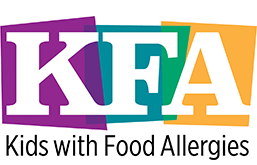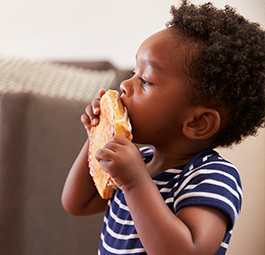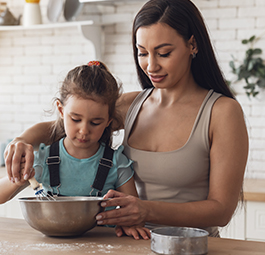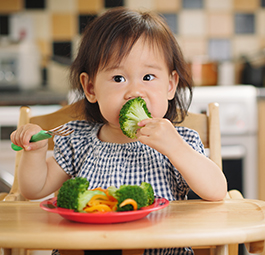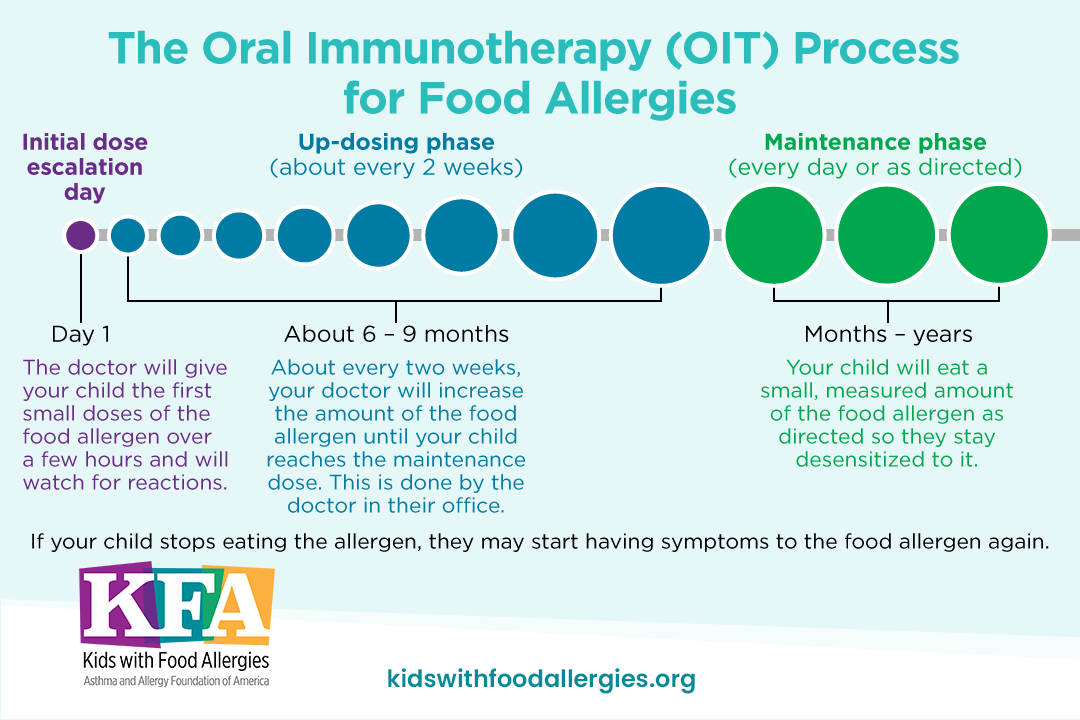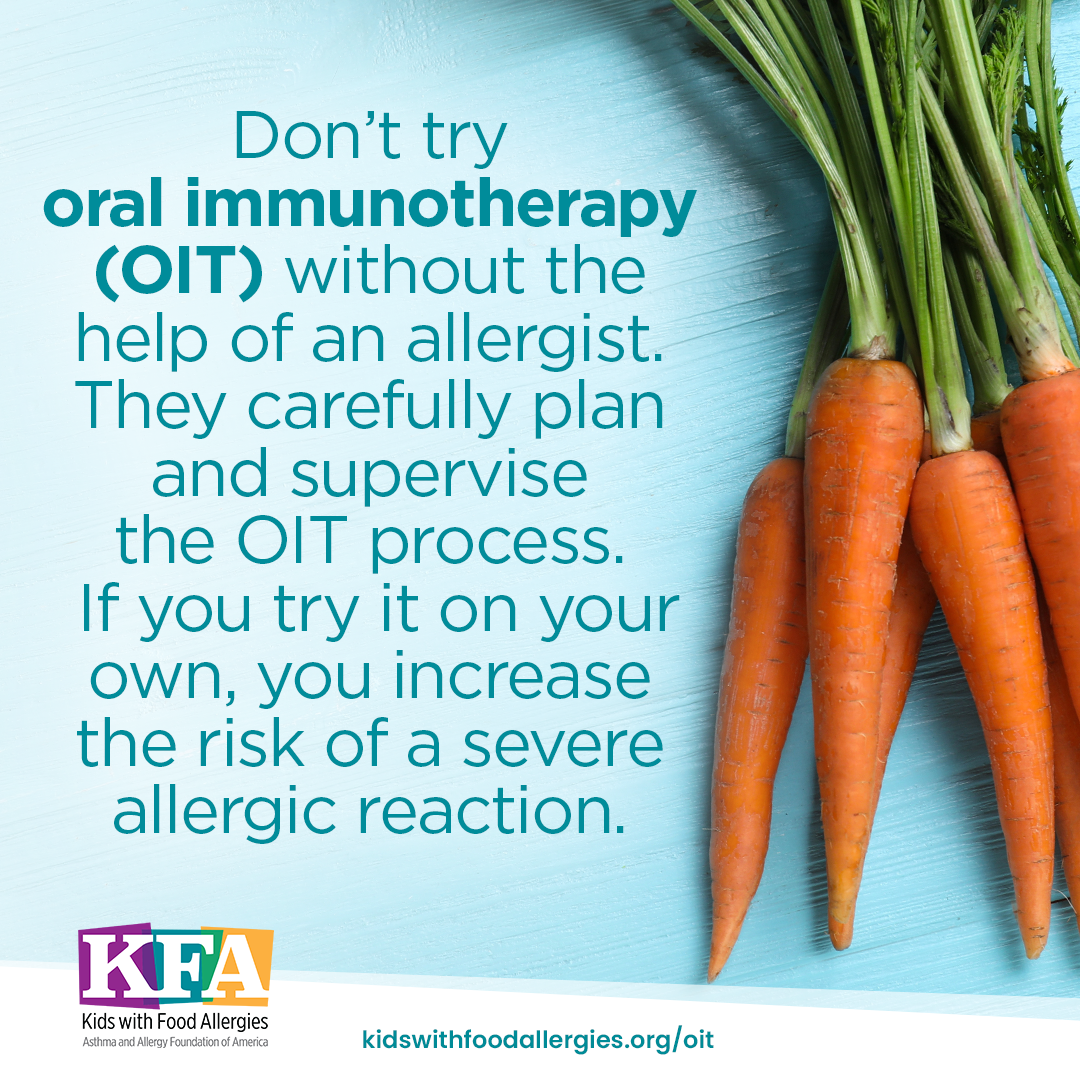Living with Food Allergies

Oral Immunotherapy (OIT)
Food oral immunotherapy (OIT) is a food allergy treatment that retrains your child’s immune system to respond differently to food. OIT is not a cure for food allergies. But it may allow your child to eat foods with less stress and worry.
Successful treatment of OIT may provide “bite protection.” This means a lower chance of having an allergic reaction if your child accidentally eats a small amount of the food allergen. Some children may even be able to eat the food freely in their diet after reaching the final stage of OIT treatment program.
You should NEVER try OIT without the help of an allergist. Your child’s allergist carefully plans and supervises the OIT process. If you try it on your own, you will put your child at risk for anaphylaxis, a severe allergic reaction.
How Does OIT Work?
OIT helps the body gradually desensitize (tolerate) a food allergen. It does this by slowly raising the amount of food allergen your child can eat before it triggers an allergic reaction.
During OIT, your child will be given a very measured and specific amount of the food they are allergic to. This is done under the supervision of a doctor, usually a board-certified allergist or immunologist. Your child will eat a tiny, controlled dose of the food they are allergic to every day.
Your child’s first OIT treatment will be done in your doctor’s office. The first four or five doses (a very small amount) will be given at one appointment. This appointment will last about three to four hours. This is called the “initial dose escalation day.” After the initial dose, your doctor will have you come back to the office about every two weeks for buildup doses (also known as “up-dosing”). The goal is for your child to slowly reach the “maintenance dose.”
Every time the doctor increases the amount of the food allergen, it is called “up-dosing.” You will do all up-dosing in the doctor’s office so they can watch your child to make sure there is no reaction. They usually watch your child for about one hour. Once the doctor determines a safe dose amount, you will continue OIT at home. You will give your child that dose amount every day until your next appointment.
The doctor will gradually increase the dose over time until you reach a target dose amount or maintenance dose. In the maintenance phase, your child must eat a measured amount of the food every day or as directed to continue to tolerate the food allergen. During OIT and while in the maintenance phase, your child will still need to carry an epinephrine auto-injector and read food labels carefully.
If your child reacts to a dose, the doctor will adjust future doses to prevent reactions. If your child tolerates all of the doses, your child will have about 11 to 13 total clinic visits to reach the maintenance dose. Most children can reach the maintenance dose in around five to six months.
If your child has reactions, sickness, or scheduling conflicts, this process may take longer. After completing initial dose escalation day and up-dosing, your child will continue taking maintenance doses at home with follow-up appointments every few months.
Common OIT Terms
Sensitization: [sen-si-tuh-ZEY-shuhn] – This is the detection of specific immunoglobulin E (IgE) through skin prick or blood testing towards a specific food. Your body may be “sensitive” to a food allergen without developing symptoms after that food is ingested. In other words, a positive allergy test result to a food that your child has eaten without any problems or has never eaten.
Desensitization: [dee-sen-si-tuh-ZEY-shuhn] – The process of reducing your allergic reactions to something you are allergic to by gradually introducing the allergen to your body in small, controlled amounts.
Oral food challenge: A method of diagnosing or confirming a food allergy. Your child eats small, controlled amounts of the food in the doctor’s office while the doctor monitors them for a reaction. Your child’s doctor may perform an oral food challenge before OIT to confirm the food allergy. The oral food challenge is the best way to confirm a true food allergy. It is the gold standard in food allergy diagnosis.
Skin prick test: The process of placing a drop of allergen onto the surface of the skin, and then pricking through it to introduce the allergen into the top layer of the skin. This may be one of the tests your child’s doctors does before starting the OIT process.
Initial dose escalation day: The first OIT appointment where your child will be given the first doses (a very small amount) over about three to four hours. The doctor will watch for reactions between each dose. This is also called “rapid desensitization” or “rush immunotherapy.”
Up-dosing: The process of increasing the amount of the food allergen every two weeks to reach the maintenance dose. It is done by the doctor in their office.
Maintenance phase or dose: Eating a small, measured dose of the food allergen every day so your child stays desensitized to it.
Bite-proof: A goal of OIT. It means your child can accidently eat a small amount of the food they are allergic to (such as from cross-contact) without having a reaction. Also called “bite-safety” and “bite-prevention.”
Anaphylaxis: [anna-fih-LACK-sis] – A severe allergic reaction that can cause symptoms such as hives, trouble breathing, stomach issues, and/or swelling of the lips, tongue, or throat. It must be treated with epinephrine right away.
Eosinophilic esophagitis (EoE): [EE-oh-sin-oh-FILL-ick uh-soft-uh-JIE-tis] – An allergic condition that causes swelling in your esophagus (swallowing tube). It can be a side effect of OIT, but it is rare.
Who Can Get OIT?
People with a mild-to-severe allergy to certain food allergens (like peanuts) may be able to receive OIT. Your child’s doctor may do an oral food challenge and/or other specific allergy tests to confirm the food allergy before beginning OIT.
The minimum age to start OIT is around 18 months of age. But the best age for starting OIT may depend on several factors, such as your child’s age, maturity, and food allergies.
OIT does offer the hope of protection from food allergy reactions, but there is not one single approach that is best for each child. Talk with your doctor to decide if OIT is the best therapy for your child.
Is OIT Safe and Effective?
The use of OIT has been studied for many years. OIT can be effective. Up to 80 to 90% of children have success with OIT.1,2 But these results may not be the same for every food.
Palforzia, also known as peanut (arachis hypogaea) allergen powder-dfnp (PTAH) or previously called AR101, is the first and only FDA-approved treatment for peanut allergy. It contains a very specific amount of peanut flour. The FDA approved it on Jan. 31, 2020. Palforzia is approved for children ages 4 to 17 who have a been diagnosed with a peanut allergy.
There are no other FDA-approved OIT treatments for other food allergens at this time. (As of October 2021.)
Many doctors have been offering OIT treatment using foods in various forms, such as a liquid, flour, or the actual food itself. These methods are not approved by the FDA. Talk with your child’s doctor about the most appropriate OIT option for your child. The FDA is looking at other food allergy treatments to fast track through the approval process to address this unmet need in the food allergy community.
There are many known side effects or possible adverse reactions to OIT.
What Are the Risks of OIT?
Your child may have side effects during OIT since they are eating the food they are allergic to. These adverse events are common and may make it necessary to stop treatment.
Most symptoms are mild, but they can also be serious. They can include:
- Itching of the mouth/tongue
- Sore, scratchy, or itchy throat
- Runny nose
- Cough
- Nausea
- Heartburn
- Vomiting/diarrhea
- Stomach pain
- Hives
- Swelling (angioedema)
- Aversion to the treatment/food (some kids hate the taste)
There is a risk for a severe allergic reaction known as anaphylaxis with OIT. Studies on peanut OIT showed a child is more likely to experience a severe allergic reaction while undergoing OIT compared to no treatment at all. Dosing in OIT is controlled by the doctor and carefully measured to reduce the risk of anaphylaxis, but there is a risk. Overall, children undergoing OIT have higher rates of anaphylaxis and use epinephrine more often than children who are not undergoing OIT.3
For peanut OIT, the risk of an allergic reaction requiring epinephrine (the treatment for anaphylaxis) may be as high as 7.6%.4
Eosinophilic esophagitis (EoE) is a possible but rare side effect of OIT. EoE is where your child’s esophagus (swallowing tube) becomes inflamed (swollen). This is an allergic disease of the esophagus that causes trouble swallowing, vomiting, and stomach pain. Around 5% of people who do food OIT develop EoE as a side effect – and most cases clear up after stopping OIT.5 The risk of developing EoE to the peanut OIT (Palforzia, PTAH) is about 1%.6
What Are the Benefits of OIT?
OIT offers many benefits. It may improve quality of life for both parents and their children with food allergies. It can offer greater freedom for families managing certain food allergies, lower stress, and can reduce the risk of anaphylaxis if the treatment is successful. (Studies have shown that during OIT, families do not experience a difference in quality of life compared to no treatment.3)
After reaching OIT maintenance phase, you and your child may be able to enjoy restaurants, birthday parties, holiday gatherings, and travel, and with less worry of a reaction from accidental exposure. It can help your child feel more included overall in many activities, such as school, sports, afterschool programs, and playdates.
Is OIT the Right Treatment for My Child?
Know what you are hoping to accomplish and ask your allergist if OIT will help you accomplish that goal. It’s important to know the factors involved in OIT and how it may impact your family. The OIT regimen will impact other areas of your life. OIT may not be right for your child.
If you move forward with OIT, you will need to commit to and follow the OIT process for success. This includes frequent clinic visits. The first day will be the longest (lasting up to four hours). You will then need to plan for up-dosing appointments about every two weeks.
You will give your child home doses of the food allergen every day on a regular schedule. You or another adult caregiver will need to supervise home dosing to prepare doses and watch for reactions. It is best if your child can take their home dose around the same time every day, usually in the morning. Make sure your child has a meal or a snack before or with their dose.
Your child’s doctor may adjust the dose if your child gets sick, starts their period, or has asthma or allergy symptoms. Continue allergy and asthma medicines as prescribed. However, non-steroidal anti-inflammatory drugs (NSAIDs) like ibuprofen should be avoided.
Have your child avoid exercise, strenuous physical activity, and hot showers for 30 minutes before and two hours after dosing. (Follow the directions from your doctor – the amount of time may be longer or shorter.) This may be challenging to schedule for some kids who are active in sports or other physical activities.
Alcohol and illicit drug use can cause adverse reactions to the OIT treatment and so it’s very important to talk with your child/teen about not using these substances.
While undergoing OIT treatment, kids must:
- Frequently visit their allergist
- Avoid physical activities and exercise for a set time before and after treatment
- Eat before the treatment dose
- Avoid hot showers or overheating near treatment time
- Avoid alcohol and drug use
- Avoid taking NSAIDs like ibuprofen
- Continue carrying their epinephrine auto-injectors
- Stick to a strict schedule
- Be aware of the risks of side effects and symptoms
This may not work well for every family, especially kids who are active in school and extra-curricular activities.
Overall, OIT is a long-term commitment. Once your child has completed up-dosing, they will have to keep taking maintenance doses. If they stop dosing, they may start having symptoms to the food allergen again.
OIT does not permanently reverse a food allergy. It may not be the right treatment for everyone. But for many families, it is a valuable treatment that can reduce stress and improve quality of life.
Can My Child Receive OIT for Multiple Foods?
OIT is most often used to manage a food allergy to one food. But OIT with multiple food allergens is still being actively studied. One study has shown positive results for OIT with multiple foods at the same time.7 But more research is needed.
If your child is allergic to multiple foods and you want to consider OIT, talk with your child’s allergist. Your child may be eligible to enroll in clinical trial studies on OIT for multiple foods or foods other than peanut.
Is OIT Covered by Insurance?
If you have no insurance or if your insurance has denied coverage for Palforzia and you meet certain financial eligibility criteria, you may be able to receive Palforzia at no cost to you. For information about the Palforzia Pathway™ Patient Assistance Program, call 1-844-PALFORZ (1-844-725-3679), option 2.
Medical Review: October 2021 by Michael Pistiner, MD, MMSc, and John M. James, MD
Sponsored by Aimmune Therapeutics. This content is developed independently by the Asthma and Allergy Foundation of America and its Kids with Food Allergies division.
References
1. Tang ML, Ponsonby AL, Orsini F, et al. Administration of a probiotic with peanut oral immunotherapy: A randomized trial. J Allergy Clin Immunol. 2015;135(3):737-744.e8. doi:10.1016/j.jaci.2014.11.034
2. Wasserman RL, Factor JM, Baker JW, et al. Oral Immunotherapy for peanut allergy: Multipractice experience with epinephrine-treated reactions. JACI: In Practice. 2014;2(1):91-96.e2. doi:10.1016/j.jaip.2013.10.001
3. Chu DK, Wood RA, French S, et al. Oral immunotherapy for peanut allergy (PACE): A systematic review and meta-analysis of efficacy and safety. Lancet. 2019;393(10187):2222-2232. doi:10.1016/s0140-6736(19)30420-9
4. Grzeskowiak LE, Tao B, Knight E, Cohen-Woods S, Chataway T. Adverse events associated with peanut oral immunotherapy in children – a systematic review and meta-analysis. Sci Rep. 2020;10(1). doi:10.1038/s41598-019-56961-3
5. Hamant L, Freeman C, Garg S, Wright BL, Schroeder S. Eosinophilic esophagitis may persist after discontinuation of oral immunotherapy. Ann. Allergy Asthma Immunol. 2021;126(3):299-302. doi:10.1016/j.anai.2020.12.007
6. Nilsson C, Scurlock AM, Dellon ES, et al. Onset of eosinophilic esophagitis during a clinical trial program of oral immunotherapy for peanut allergy. JACI: In Practice. 2021;0(0). doi:10.1016/j.jaip.2021.07.048
7. Multi-food oral immunotherapy found to be safe and effective. American Academy of Allergy Asthma & Immunology. (n.d.). Retrieved October 14, 2021, from https://www.aaaai.org/About/News/News/multi.
